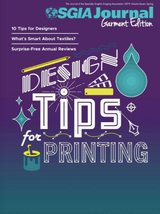Professional Tip & Tricks
Professional Tip & Tricks
Using Heat Transfers Correctly
On our "Heat Transfer Paper" page we explained the technical aspects of heat transfer paper. Now on heat transfer tips and tricks let's look at some important business aspects, when using the paper. One of the most difficult tasks for new and even experienced entrepreneurs to accomplish is to keep their biases out of their business decisions and methods. When they don't, they limit their opportunities.
From a practical business viewpoint, what you like and don't like is not very important. The two really important questions are what does my customer want and can I deliver a value with that product that keeps us both happy?
This is the main reason that we offer economically priced “Alpha Sampler Packs”. One sampler pack contains 20 each of all five of our heat transfer papers. The other sampler contains twice that much paper, with additional savings.
The Alpha Trial sampler provides 4 sheets of each paper.
If you are positive that you will be producing only one type of shirt look, then get a 25 or 100 sheet pack of the only one that you want. If you are not sure, then get the sample pack.
The sample pack contains enough heat transfer paper to let you practice a bit, make a sample of each and still be able to produce a small order.
Samples are important! Most of your customers will have no ability to visualize what you are talking about. An old sales axiom states “Unseen is usually unsold”. Believe it!
About Washing Instructions
(Click to Expand)
Washing instructions are simple and the same for every heat transfer type:
“Turn the garment inside out, wash in cold water with no bleach, on a gentle cycle. Remove the garment within a few minutes of the spin cycle finishing. Dry onhigh/cotton setting and remove as soon as possible, after drying, and shake out the shirt.”
The instructions are simple but some customers won’t follow them. A few will return the garment (of course swearing that they followed the instructions exactly) and expect you to do something about it.
What you do is your decision, but here are some clues that tells you what happened-
- T-shirts are almost always washed with other items. Some items are quite abrasive (like towels) and if the shirt is not inside-out, friction can cause quite a bit of wear and tear.
- Washing in cold water reduces color loss (just like it does for the dyes in colored fabrics). Most times, however, a decorated shirt is in with a full load of whites and will be washed in hot water. This won’t destroy a good heat transfer but the color loss is more noticeable with OEM inks.
- Bleach is used to remove color stains. Some soap actually has quite a bit of so-called “color-fast” bleach in them. Again that doesn’t destroy an image, but it doesn’t help.
- It makes sense that a gentle cycle reduces the violence of friction caused by garments rubbing together.
- 99% of the time, a shirt was left in the washer too long, if a customer returns a shirt that looks like the colors have bled. This is caused by osmosis, not by anything that you did. Fading after one wash (as opposed to bleeding) is usually caused by bleach or ink that is too water soluble.
- Quickly removing a garment from a dryer is fairly important. Even if you dry on low to medium heat, the middle of a load of clothes is hot! If a wadded-up shirt stays in a dryer with 20-30 lbs. of clothes on top of it, it will look a little crumpled when it comes out of the dryer.
It is not necessary to over-think potential care problems but knowing the results of improper care can help you.
Making A Profit
(Click to Expand)
- There are many good brands of shirts, suitable for heat transfers. A nice basic 6.1 oz. shirt is produced by “Gildan”. We decorated a few ten thousand of those in our old retail days and always had good luck with them.
- T-shirt suppliers abound on the web. However, it would also be a smart idea to check in your town or the closest big city near you. Look in the Yellow Pages under, “T-shirts – Wholesale”. Freight is not getting any cheaper and close suppliers can also be very handy when you need to fill a rush order.
- Heat transfer paper is deadweight and expensive to ship overnight. Keep a little extra on hand, to avoid expensive overnight freight charges.
- Look for anyone wearing unusual or striking clothing at a special event. They are a natural to want their picture
- Miss no opportunity to take a picture of a child with a pet or engaged in sports. When the customer buys, ask if they think granddad/mom might like one.
- If you are taking photographs at a special event, consider having a price for one shirt and giving small discounts for 2, 3 and 4 shirts with the same picture. Call it a "Family Special". This encourages customers to buy more than one, perhaps even for family members that are not there.
- Remember that "Unseen is Unsold". T-shirts are a visual medium and prospects have little imagination. Make samples of every single thing that you want to sell. You might even consider having at least one really nice type of shirt. They cost more but…they sell for more.
![]() While you probably can't make an actual sample of everything that you can produce, you can have a portfolio of designs, Also at special events you could have "mix and match" sets of caps and shirts, to help sell more.
While you probably can't make an actual sample of everything that you can produce, you can have a portfolio of designs, Also at special events you could have "mix and match" sets of caps and shirts, to help sell more.
How about a his-n-hers coordinated set with a shirt and cap!
Production Tips
- Don’t buy a lot of new (to you) garments, until you test them. Some manufacturers put a stain resistant chemical in their fabrics. Heat turns this chemical in the fabric, brown. Test, before you buy a lot.
- Let your print dry for a few minutes (especially if it has heavy, dark colors). If you are in a hurry, hold the transfer paper by a corner and "wave" it in the air for a few seconds.
- To help reduce cracking, stretch your shirt, a lot, just before putting it onto the heat press.
- If part of your transfer is coming off when you peel it, you probably need to increase your pressure a "tinch".
- If you don't have one, buy a paper cutter. You have to trim heat transfers. A paper cutter is much faster and easier.
- Inkjet printers cannot produce a "white" color. It's impossible. If you have to design some with white, make it an off-white. This is why problems with photographs are rare. Photographs almost never have anything pure white in them.
- Lettering, by itself, does not look good on a shirt and who has the time to individually trim each letter. Here's two ways to handle lettering. If it goes with a graphic or photograph, put the lettering on it. If the transfer is just lettering (like a name), try this trick. Draw a proportionally thick (relative to letter size) rectangular box around the name. Fill in the box with a coordinated background color. The transfer is easy is easy to trim and looks great, if you do it right.
- Orientating an irregular shaped transfer, which has been cut with scissors, can be difficult. Here's an easy help. Make sure your image is printed on the paper with the exact same orientation that it needs to have on the shirt. Before you trim your transfer, flip it over and draw a cross hair over the image. It doesn't have to be exactly in the middle and you can use the paper edges to make sure it is an exact cross hair. When you put your image on the shirt, make sure each of the cross hairs evenly point to the sides of the press. You will still need to pay attention to position but at least you will know that your image is not turned to the wrong angle.
- For most, peeling a transfer from a hot shirt is no problem. What is sometimes difficult is holding the hot shirt down, with the other hand. An oven glove or mitten is clumsy. Use a potholder. It is easy to pick up and hold between thumb and fingers.
- Don’t have a thumbnail to speak of? Here’s a trick to help you peel your hot transfer. Cut up very small pieces of copier paper. Nudge one of these small pieces under the bottom corner of your transfer (but not up into the picture). When you heat your transfer, the film will stick to the paper. Viola! Instant tab.
- Heat transfers can be trimmed all the way to the edge of the picture. Many use scissors, a paper cutter or a box cutter (along with a straight-edge). When trimming Alpha Gold Dark we prefer a roller cutter (like is used for fabrics). Here’s why. A pointed instrument pulls, as it cuts. This can stretch the paper and leave a white line around your image. A roller cutter does not stretch the film on the paper.
- Here's another tip about Alpha Gold Dark (or any other opaque paper). Sometimes folks with no fingernails have the dickens trying to get the film off the paper back. Click Here, to see an easy method.
Stuff You Should Know
- Protect paper from moisture by putting it back in the package when you are finished. Never store paper on the floor or around an air conditioner.
- Moisture in a garment can also mess up a transfer. Again, keep shirts protected. If you think you have a moisture problem, put the shirt on the press and pull the heat press head down to the shirt (you don't have to lock the press), for about three seconds. This will evaporate moisture. When you lift the heater head, "brush" off the garment with a clean rag. This removes enough surface heat to keep your transfer from sticking, as you position it on the shirt.
- Don't just tell your customers about washing instructions, print them and include them with every shirt. Put instructions on a piece of paper large enough that they won't be overlooked.
- Shirts shouldn't be washed for at least 24 hours, after transferring. Give the image time to "settle down".
- Teflon Sheets can be a real friend. It is one of those things that is much better to have and not need it, than it is to need it and not have it. Teflon easily wipes off. A Teflon sheet on top of your shirt and transfer blocks any build-up of inks or adhesive (from the transfer edges) from building up on your heater block. A sheet of Teflon inside your shirt keeps what is called "blow-through" from being able to happen (This is where loose weave fabrics have a tendency to allow some of the film to blow through, to the other side of the shirt). A Teflon pad slips onto the bottom of a heat press, like a mattress cover. This allows you to easily slide garments on and off your press. It also blocks excess dye (from colored shirts) and other grunge from building up on the rubber pad.
- Never leave a heat press turned on and unattended. Yes, they are very safe, but why take a chance?
The beauty of starting a heat transfer business is that it can be as simple or involved as your business dreams and budget allow.
Even with all of our information, many questions sometimes remain. It is never a bother to answer questions and it is always a pleasure to make a new friend. Call us: Roy or Jack at 800-908-9916.
This is the end of your basic tour. We conclude it by offering you one of our sayings, using the three basic building block words we discussed at the beginning of this section-
"Patiently plan your work and then persistently work your plan." You will succeed.
Demonstration
Our last demo provides several useful heat transfer tips and tricks and ideas. We used a cap for a demo showing a different way to use Alpha Gold Dark heat transfer paper (used for dark colored fabrics). The method works for shirts too.
Bottom line, we wanted to produce a humorous graphic, on a colored fabric, with white lettering.
 First, we created a yellow frame. Next, we pulled the two pieces of clipart into the frame and positioned them. At that point we could have just added black text (run your cursor over the hat to enlarge), printed our design and transferred it to the cap.
First, we created a yellow frame. Next, we pulled the two pieces of clipart into the frame and positioned them. At that point we could have just added black text (run your cursor over the hat to enlarge), printed our design and transferred it to the cap.
What would have happened, however, is that the background would have been white and made the design look like a patch. We didn't want that kind of look. Instead, we used our color tool to automatically fill in a red background (Note: We picked a red that we thought coordinated with the cap. It is virtually impossible to match an inkjet ink to a dyed fabric).
We then typed our text message in white. Inkjet printers cannot print white, so when it comes to "white" letters, it prints nothing. The white letters are produced by the white of the Alpha Gold film.
While we just produced our cap for a showroom sample and a picture, our mail carrier demanded to buy it. We gave it to him with our compliments.
We deliberately chose a cap for the last thing on our tour so you would keep them in the back of your mind. A great number of the same folks who buy T-shirts, buy caps.
![]() Adding a Rhinestone or two turns a simple image on a shirt into a 3-D effect that adds perceived value to your customers. It provides a whole new dimension for pennies!
Adding a Rhinestone or two turns a simple image on a shirt into a 3-D effect that adds perceived value to your customers. It provides a whole new dimension for pennies!
As a general closing thought, remember where your competitive niche is located. While you may occasionally offer preprinted transfers, printing your own transfers provide these additional advantages. You can profit with small orders. You can offer very fast turn-around time. You can easily offer full color. You can do "on-demand" printing, as needed. You have no dead inventory, from a pre-printed T-shirt not selling. If you have artistic or photographic talent, why pay someone else for their work.
However, there is one specific situation where it makes perfect sense to have transfers made for you (to be applied with your heat press). This is where you have an order for several hundred, of the same design, using one or two colors.
If you have a need for that service, call us and we will share some excellent sources for volume, custom printed transfers.
Whew! We know this has been a long "Heat Transfer Tips & Tricks" tour and congratulate you for hanging in there with us.
Hopefully, you know a lot more than when you started. In building for success, there is no substitution for education.
Because you probably still have some unanswered question, we again encourage you to call us. Whatever we know is yours for the asking.
Recent Posts
-
SGIA Journal
SGIA's spring addition for all things design, print, and artists.SGIA Spring Addition …16th May 2019 -
Forever Flex-Soft (No-Cut) Tagless Shirt Application
…11th Jun 2018 -
Graphtec Media Loading & Test Cut
…4th Jun 2018





